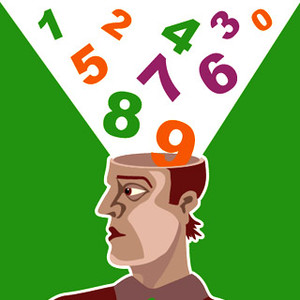In a study that involved teaching monkeys to associate Arabic numerals with their corresponding quantities, German researchers fingered the prefrontal cortex as the part of the mammalian brain that is responsible for relating symbols with abstract concepts.
The finding was surprising to the Andreas Nieder, head of the Primate NeuroCognition Laboratory at the University of Tübingen, and his graduate student Ilka Diester, who figured that the intraparietal sulcus, a lateral region in the rear brain, handled this task.

|
| ©ISTOCKPHOTO/DAWN HUDSON |
| Scientists say the prefrontal cortex is responsible for making semantic connections between numerical quantities and the symbols that depict them. |
"In verbally counting humans, the parietal cortex seems to be the key structure for symbolic number representations," Nieder says, about the study result is published this week in PLoS Biology. "Damage to certain parts of the parietal lobe in humans can elicit very specific deficits in dealing with numbers."
Instead, researchers discovered that the semantic associations are made in the prefrontal part of the cortex (the brain's central processing area), indicating that this region in children and monkeys is involved in the early learning of numeric links - such as that between the numeral 4 with the quantity of four dots - and that the parietal region takes over the job in teens as the associations become more automatic. In fact, imaging studies of children have shown that their prefrontal areas are heavily engaged when drawing connections between symbols and concepts.
Nieder and Diester trained two rhesus monkeys for their experiment. First, they taught the animals to discriminate between different quantities by showing them sets of dots and having them pluck out the ones with equal numbers of dots (from one to four) on them. They then spent several months linking each set of dots to different Arabic numerals.
Following the lessons, the researchers gave the monkeys performance tests during which they were trained to pull a lever when a numeral and its matching number of dots appeared before them. The monkeys made the correct association nearly 90 percent of the time. As the animals mulled their options, researchers scanned 692 randomly selected neurons in the prefrontal cortex and 437 nerve cells in the parietal cortex. The researchers found that 23 percent of the prefrontal neurons showed increased activity during the task, but only 2 percent of the parietal neurons responded.
In addition, groups of neurons in the prefrontal cortex appeared to be tuned to certain amounts, with subsets of the cells responding to specific numerals or quantities: some to 1, others to 2 (and so on). In addition, if a monkey was about to make an incorrect decision, Nieder notes, the researchers observed a very different pattern of activity in the prefrontal neurons than what appeared when they were correct.
Jamie Roitman, a research assistant professor at the University of Illinois at Chicago, says the new study clears up an unanswered question in numerical cognition: whether there are two steps in naming a numerical value. Previously, it was believed that the brain first learned to summate a quantity of beads or dots or dogs, etcetera, and that higher quantities would be met with greater activity in neurons. Then, a second set of neurons (in the parietal cortex) would determine the corresponding cardinal value - 1, 2, 3, 4 and so on. "[The new study] finds that neurons in [the] prefrontal cortex respond similarly when viewing a stimulus of four dots or the symbol '4,' as if these neurons are able to map the symbol onto the cardinal value," she says. "It suggests that this kind of association between symbols and what they represent may occur in the activity of prefrontal neurons."
Nieder believes the work can be applied to humans. "Humans learn to use symbols as mental tools during childhood; prior to the utilization of signs as symbols, long-term associations between initially meaningless shapes and semantic categories must inevitably be established," he says, noting that animals are capable of making rudimentary associations, as shown in this study. "In animal models, we have a chance to learn about the cellular mechanisms underlying such cognitively demanding tasks."



Reader Comments
to our Newsletter